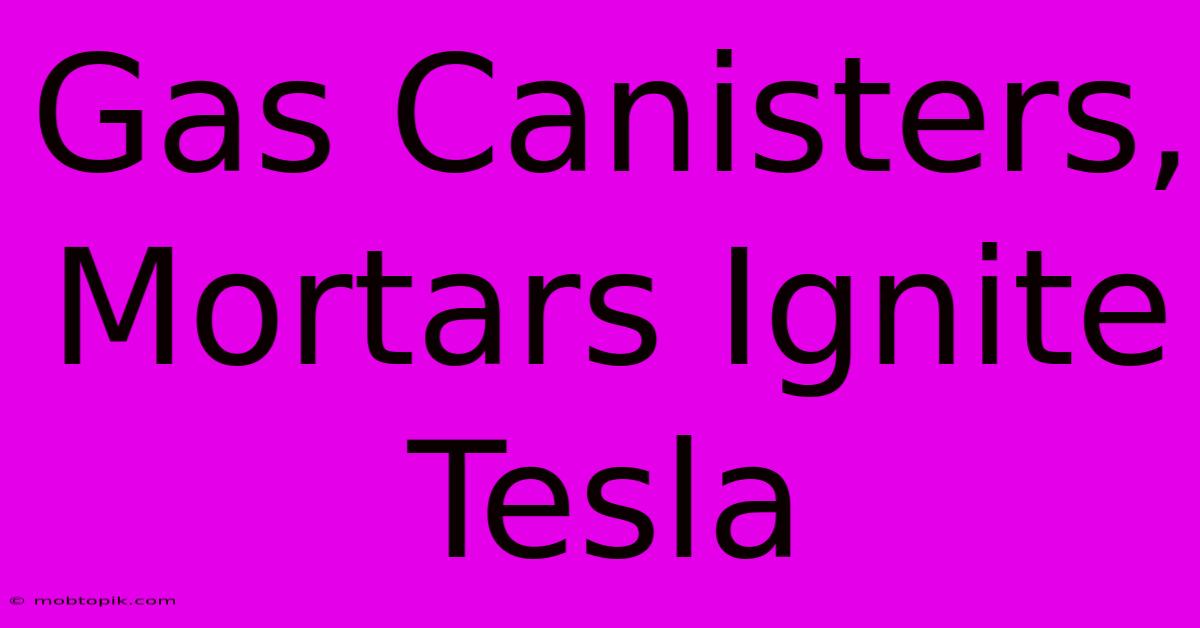Gas Canisters, Mortars Ignite Tesla

Discover more detailed and exciting information on our website. Click the link below to start your adventure: Visit Best Website mobtopik.com. Don't miss out!
Table of Contents
Gas Canisters, Mortars Ignite Tesla: A Deep Dive into the Dangers of Improvised Explosives
The recent incident involving gas canisters and mortars igniting a Tesla has highlighted a terrifying intersection of readily available materials and devastating consequences. This event, while specific, underscores a broader concern about the dangers of improvised explosive devices (IEDs) and the vulnerability of even advanced technology to such attacks. This article will delve into the specifics of this incident, analyze the potential causes, explore the dangers of using gas canisters and mortars as explosive devices, and discuss the implications for safety and security.
Understanding the Incident:
News reports detail a scenario where individuals, using gas canisters and mortars as improvised explosive devices, caused significant damage to a Tesla vehicle. While precise details may vary depending on the source, the core elements remain consistent: the use of readily accessible materials to create a dangerous and destructive device. The exact type of gas canisters and mortars involved hasn't been universally reported, highlighting the need for improved reporting standards in such incidents. However, the incident itself serves as a stark warning.
The Dangers of Improvised Explosives:
Improvised explosive devices, by their very nature, are unpredictable and incredibly dangerous. The lack of standardized manufacturing processes means the potency, timing, and overall behavior of these devices are highly variable. This unpredictability makes them exceptionally hazardous for those constructing them, those near the detonation site, and even for emergency responders.
Gas Canisters: A Surprisingly Lethal Ingredient:
Propane and butane canisters, commonly found in households and campsites, are frequently misused in the construction of IEDs. These canisters are pressure vessels containing highly flammable gases. When subjected to heat or impact, they can rupture explosively, creating a fireball and shrapnel. The combination of the gas's flammability and the canister's fragmentation potential creates a significant blast radius and lethal shrapnel.
- Pressure buildup: The internal pressure of a gas canister is extremely high. Any damage to the canister can lead to rapid pressure release, resulting in a violent explosion.
- Flammable gas: The gas itself is highly combustible. A small spark or flame can ignite the released gas, leading to a large fire.
- Shrapnel: The metal fragments of a ruptured canister become extremely dangerous projectiles.
Mortars: Adding Explosive Power:
Mortars, while designed for military applications, can also be misused in IED construction. Their design incorporates a propellant charge that, when ignited, propels a projectile (a mortar shell) significant distances. In the context of an IED, this propellant charge can be repurposed to amplify the destructive potential of the gas canister.
- Amplified Blast: The explosive force of the mortar propellant significantly enhances the power of the gas canister explosion.
- Increased Range: While the gas canister explosion has a limited radius, a mortar-based IED can propel projectiles and explosive force over a much larger area.
- Unpredictable Trajectory: The trajectory of the projectiles is difficult to control in an improvised setting, increasing the danger to innocent bystanders.
Tesla's Vulnerability: An Unexpected Target:
The choice of a Tesla as the target is noteworthy. While the electric vehicle itself might not be inherently more vulnerable than a combustion-engine vehicle to this type of attack, the technology within a Tesla presents additional concerns:
- Battery Fire Risk: A Tesla's high-voltage battery pack is a significant fire hazard. The heat generated by the explosion could easily ignite the battery, causing a prolonged and intense fire.
- Electronics Vulnerability: The intricate electronic systems within a Tesla could be damaged or destroyed by the blast.
- Data Security: The impact of the explosion may compromise data security, potentially exposing sensitive information.
Preventing Future Incidents:
The incident involving the gas canisters and mortars underscores the need for enhanced safety measures and preventative strategies:
- Stricter Regulations on Explosives: Strengthening regulations surrounding the sale and storage of materials that can be used to construct IEDs is crucial.
- Public Awareness Campaigns: Educating the public about the dangers of improvised explosive devices and the potential consequences of their misuse is essential.
- Improved Security Measures: Developing and implementing enhanced security measures to protect potential targets, including electric vehicles, is necessary.
- Enhanced Law Enforcement Response: Improved training and resources for law enforcement agencies to respond to and investigate IED incidents are critical.
Conclusion:
The incident where gas canisters and mortars ignited a Tesla serves as a stark reminder of the ever-present danger posed by improvised explosive devices. The readily available nature of materials used in their creation, coupled with the potential for devastating consequences, necessitates a multi-pronged approach to prevention and mitigation. This includes tighter regulations, public awareness campaigns, and enhanced security measures to protect lives and property. The incident highlights not just the dangers of IEDs but also the vulnerability of advanced technology in the face of deliberate malicious intent. The focus must shift toward proactive measures to prevent such incidents from occurring again. The safety and security of individuals and communities should remain the utmost priority.

Thank you for visiting our website wich cover about Gas Canisters, Mortars Ignite Tesla. We hope the information provided has been useful to you. Feel free to contact us if you have any questions or need further assistance. See you next time and dont miss to bookmark.
Also read the following articles
| Article Title | Date |
|---|---|
| Buxton Match Postponed New Years Day | Jan 02, 2025 |
| Fireworks Ignite Cybertruck At Trump Event | Jan 02, 2025 |
| Asu Defeats Skattebos Despite Strong Showing | Jan 02, 2025 |
| Cybertruck Burns Near Trump Hotel In Vegas | Jan 02, 2025 |
| Cam Skattebos Remarkable Arizona Season | Jan 02, 2025 |
